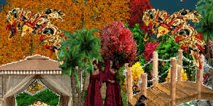COLONIAL REVIVAL
Following the patriotic celebrations of the 1876 Centennial, a new interest in American history inspired a revival of American Colonial architecture. Designs for houses for such fashionable architectural forms as McKim, Mead and White incorporated distinctive Colonial-era features, including the Palladian window, columned porticos, doors and windows pediments, and classical swags and urns. In its early phase, beginning in the 1880s, the Colonial Revival was limited to opulent, large houses in exclusive neighbourhoods and summer resorts. By the 1920s, it was the favoured style for more modest and suburban houses and has been popular since. The traditional colours for the early Colonial Revival houses was white, cream or pale yellow, with trim and shutters highlighted in a dark shade, such as green, blue, red or black. Red, brown, grey, blue and green have also become popular body colours, use any of these with contrasting trims.
GEROGIAN REVIVAL VERNACULAR OR FOURSQUARE
These plainspoken houses were built around the simple principle of the Georgian square or rectangular block, usually with a front porch and a sensible floor plan of four rooms on each floor arranged one in each corner. Foursquares were usually covered in clapboard, but there are certainly examples of the style in stone, brick and stucco. The style predominates in the small towns of the Northeast and Midwest, but at least one classic American foursquare can be found in most older residential estates.
EARLY SEARS PREFABRICATED
Between 1908 and 1940, Sears, Roebuck and Company sold more than 50,000 precut homes- kits that included everything from blueprints to lumber and nails. The kits were shipped by rails, so most Sears homes were built in the Northeast and Midwest, the areas best served by rail lines. Styles were wildly eclectic -buyers paging through a Sears' "Catalogue of Modern Homes" could choose anything from a simple bungalow or cape or English or Spanish Mission-style cottage. Many Sears homes still stand today, particularly in the Midwestern farming communities that were once so dependent on mail-order goods.
BUNGALOW
From its birth in the 1900s through its boom through the following two decades, Americans were crazy about the bungalow. These solid, snug, one or one-and-a-half storey homes fed the need for affordable, modern housing, and they became one of the most popular housing styles. The typical bungalow featured a deep porch, incorporated under a wide, overhanging roof; a long, low profile and a simple interior with lots of built-in cupboards and nooks. Cheap and easy to build, bungalow designs were published in magazines and sold through the mail. Their porches and shady interiors were intended for warm-weather Southern and Western climates, but the styles spread into far frosting regions before its popularity faded.
CRAFTSMAN
Inspired by the English Arts and Crafts Movement, the Craftsman style is closely associated with the furniture maker, and designer Gustav Stickley, who published numerous designs for modest houses and bungalows in his Craftsman magazine (1901-16). The style, which reached the peak of its popularity in the 920s, is also identified with the works of such California masters as the architects Greene and Greene, who rejected mass-produced materials and emphasized fine craftsmanship in wood and stone. The braod overhanging roof, deep porch, often sheltered by pergolas or trellises, and the horizontal lines of the Craftsman bungalows are the distinguishing features.The typical palettes incorporated natural greys, browns and greens to blend with the natural settings.




































Great info, Sans, thanks for posting it! :)
ReplyDelete- Grace
Keep on lecturing my dear, it's always interesting! Yes, I'm pleased to be at home, we had pasta al pesto today and Matteo is at home with us. But do you know? this morning I woke up and I could not realize where I was.... I did not recognize my own bedroom!and more over I keep thinking in English! Weird, isn't it? A big hug to you and Fay and Marg and Fafa, you definitely ARE fabulous!
ReplyDeleteLove this blog. So much of mini houses is about the architecture! Thanks CM aka Lefty
ReplyDeleteMe encanta toda la información que nos das sobre los diferentes estilos arquitectonicos.
ReplyDeleteBesitos, May.
I am so glad some of you find this post useful :):). Sure took me a while to copy type every word from that book !! hehe!
ReplyDeleteGEROGIAN REVIVAL VERNACULAR OR FOURSQUARE, this is my house. Also called a Denver four square, you could buy the plans or kit house from Sears, back around the turn of the century. You can find these homes across America in many little old towns. Ours was built sometime after 1907 but,has an extensive addition on it now. Our neighbor's house is in tact as the original, we look to his to bring ours back in time. Our house had been converted into a duplex (two apartments) during the depression years.
ReplyDelete